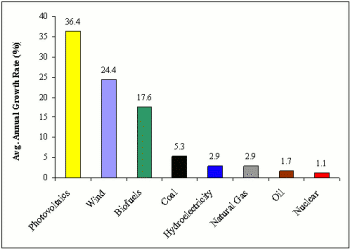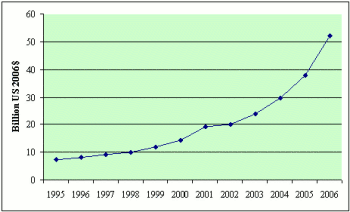The Costs of Delay
The Stern Report, compiled for the UK government and released in late 2006, estimates that the costs of climate change under a “business-as-usual” scenario could equal the loss of 5 to 20 percent of gross world product each year. In contrast, the report puts the costs of efforts to avoid the worst impacts at only about 1 percent of gross world product. Since then, the International Energy Agency and the Intergovernmental Panel on Climate Change have issued similar conclusions.
In other words, the costs of early action will likely be several orders of magnitude below those of inaction. If the world delays in its response, the steeper reductions that will be required to avoid an average temperature increase above 2 degrees Celsius (the limit considered critical for preventing catastrophic climate change) will increase costs considerably.
And the costs associated with delay will not just be economic. In March of this year, U.N. Secretary-General Ban Ki-moon warned that upheavals resulting from the impacts of climate change, ranging from droughts to inundated coastal areas and loss of arable land, “are likely to become a major driver of war and conflict.” In April, a report written with input from 11 of the most respected retired U.S. admirals and generals found that “climate change poses a serious threat to America’s national security” and that the effects of climate change “have the potential to disrupt our way of life and to force changes in the way we keep ourselves safe and secure.”
Toward a Low-Carbon Future

Around the world, a small but growing number of government and business leaders are beginning to recognize the benefits to be gained by industrialized and developing countries alike when they choose a low-carbon path. Tremendous opportunities await, and those countries that begin down this path early on will see the greatest benefits as markets around the world open up for clean energy technologies. California Governor Arnold Schwarzenegger’s decision to sign the Global Warming Solutions Act , which creates a mandatory cap on the state’s greenhouse gas emissions, was based in large measure on the arguments of Silicon Valley entrepreneurs and investors, who noted that the potential wealth and job creation of such legislation would far outweigh the costs.
With the rapid development of carbon markets, energy-efficient technologies and practices, and renewable energy sources, the tools needed to achieve significant emissions reductions are at hand. The potential for energy efficiency and renewable energy is enormous; combined, these resources provide a robust alternative to our current energy system, providing the diverse array of energy services that the world’s modern economies demand. A report released in January by the American Solar Energy Society found that energy-efficiency measures can enable U.S. carbon emissions to remain stable through 2030, while renewable energy offers the potential for dramatic reductions in emissions. Numerous other studies demonstrate the promise of these resources in meeting energy needs around the world.[1]
Wind and solar power are growing at double-digit rates, and investment in clean energy technologies is soaring—exceeding $50 billion for new renewables capacity in 2006 alone (excluding large-scale hydropower), up from $38 billion in 2005.[2] (See Figures 1 and 2.) Solar photovoltaics (PVs), while representing only a tiny share of current global energy demand, are experiencing rapid technology advances and explosive growth. In just the first half of 2007, the number of PV cells manufactured nearly equaled the total production of the entire previous year, according to the Massachusetts-based Prometheus Institute.[3]

On the efficiency front, literally hundreds of technologies—from light bulbs to appliances to aircraft—can be made more efficient than they are today, in many cases by incorporating options that are currently available, such as hybrid electric vehicles and compact fluorescent light bulbs (CFLs). Buildings now consume more than 40 percent of the world’s energy, but we can reduce their energy needs in the range of 50 to 80 percent simply by integrating intelligent design with key efficiency measures. And we could achieve significant economic savings in the process.[4] Efficiency improvements in transport can be made by increasing the role of public transportation, making our cities more pedestrian and bicycle friendly, and reducing our overall dependence on automobiles.
In 2007, the McKinsey Global Institute concluded that the rate of annual improvement in global energy productivity between now and 2020 could be doubled from 1 percent to 2 percent, slowing the rate of energy demand growth to just 1 percent per year. Other reports propose that improvements in global efficiency could be even greater.[5]
A Full Accounting of the Records
Not only can a rapid and dramatic scale-up in these technologies provide the emissions reductions required to stabilize the global climate, but they offer a host of additional benefits that will help to offset any economic costs associated with climate-change mitigation. These benefits include job creation, healthier people and ecosystems, and cleaner air and water for current and future generations. And renewables combined with improvements in energy productivity will address simultaneously many of the other major challenges that countries around the world face today. They can help alleviate poverty, reduce concerns about future energy supply and the costs of energy imports, and strengthen national security.
Some adjustments will be required as the world transitions to a cleaner energy future. For example, as new jobs are created in new industries, others will be lost, requiring re-training of workers now employed by less-efficient or more-polluting industries. Societies have faced such disruptions in the past—many scribes were left temporarily idle after the dawn of the printing press, and whalers laid down their harpoons and found other professions during the transition to petroleum oil and then electricity for lighting. Although adjustments were difficult for many people and industries, few would argue that we should turn back the clock. Such transitions also bring enormous opportunities that offer the potential to make everyone better off.
The resource base for renewables and efficiency is ample, and these technologies are available today and are ready to be scaled up to rapidly meet a far larger share of global energy demand. It will take time for renewable energy to displace fossil fuels—just as it took decades for oil to replace coal and wood. But this transition is already well under way. The main factors limiting the pace of change today are the economic challenge of accelerating investment in new energy options and the political challenge of overcoming institutional barriers to change—challenges that can be addressed with political will and strong, consistent policies that account for the benefits of clean energy and put a price on carbon. The urgency of the world’s climate problem means that we must move forward full-speed ahead.
As Sir Nicholas Stern stated at a recent briefing in Washington, D.C., seriously addressing climate change does not mean we must sacrifice economic growth; in fact, with the right framework and policies in place, the world could achieve faster economic growth than would otherwise be the case, while attaining true sustainable development.
Janet L. Sawin is a senior researcher and director of the Institute’s Energy and Climate Change team. This piece is the second installment in a three-part series of briefs on the importance of the White House climate conference, being held September 27–28, 2007.
Endnotes
1 See, for example, response to letter to the
editor in World Watch, January/February 2007, pp. 2–4; Greenpeace
International and European Renewable Energy Council, Energy [R]evolution:
A Sustainable World Energy Outlook, January 2007; and Jan Hamrin, Holmes
Hummel, and Rachel Canapa, “Review of Renewable Energy in Global
Scenarios,” prepared for the International Energy Agency Implementing
Agreement on Renewable Energy Technology Deployment, June 2007.
2 2006 from REN21, Renewables Global Status Report
2007, draft as of May 2007; 2005 from REN21, Renewables Global Status
Report 2006 Update (Paris: REN21 Secretariat and Washington, DC:
Worldwatch Institute), p. 3. Figure 1 from the following sources: BTM
Consult, European Wind Energy Association; American Wind Energy
Association; Global Wind Energy Council, “Global Wind Energy Markets
Continue to Boom—2006 Another Record Year,” press release (Brussels: 2
February 2007); Paul Maycock and Prometheus Institute, PV News, various
issues; F. O. Licht; BP, Statistical Review of World Energy 2007
(London: 2007). Figure 2 from REN21, Global Status Report 2007, draft;
and REN21, Renewables Global Status Report 2006 Update.
3 Prometheus Institute, PV News, September 2007.
4 Janet L. Sawin and Kristen Hughes, “Energizing
Cities,” in Worldwatch Institute, State of the World 2007: Our Urban
Future (New York: W.W. Norton & Company), pp. 90–107.
5 See United Nations Foundation, “Realizing the
Potential of Energy Efficiency: Targets, Policies, and Measures for G8
Countries,” Executive Summary (Washington, DC: July 2007).